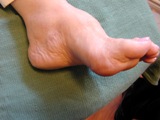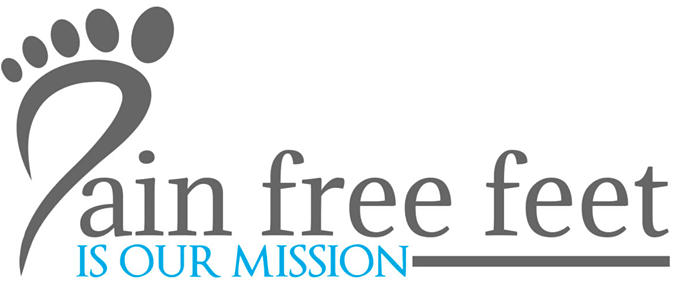Neuromuscular problems such as poliomyelitis, cerebral vascular accidents (stroke) and Charcot Marie Tooth can suddenly change the shape of the foot. Generally, neuromuscular problems will cause the foot to adopt a high arch (pes cavus) depending on the muscle groups affected in the lower leg. These neuromuscular conditions can cause the muscles to become either paralyzed or spastic. These muscle changes can result in excessive pressures being subjected to the balls of the foot and heel area.
Charcot Marie Tooth Disease
 Charcot-Marie-Tooth (CMT) is one of the most common nerve-related disorders passed down through families. CMT leads to damage or destruction to the covering around nerve fibers (similar to the covering around an electrical wire).
Charcot-Marie-Tooth (CMT) is one of the most common nerve-related disorders passed down through families. CMT leads to damage or destruction to the covering around nerve fibers (similar to the covering around an electrical wire).
Symptoms
In general, CMT affects the nerves that stimulate movement. The nerves in the legs are affected first and most severely.
Symptoms usually begin between mid-childhood and early adulthood. They may include:
- Very high arched feet (pes cavus)
- Foot drop (inability to hold foot horizontal)
- Loss of lower leg muscle mass, which leads to skinny calves
- Numbness in the foot or leg
- “Slapping” gait (feet hit the floor hard when walking)
- Weakness of the hips, legs, or feet
Later, similar symptoms may appear in the arms and hands, which may include a claw-like hand.
A muscle biopsy or nerve biopsy may confirm the diagnosis. Nerve conduction tests are often done to tell the difference between different forms of CMT.
Treatment
There is no known cure for CMT. Physical and occupational therapy may help maintain muscle strength and improve independent functioning. Ankle foot braces, orthopedic shoes and/or orthopedic surgery may make it easier to walk.
Outlook (prognosis)
Charcot-Marie-Tooth disease slowly gets worse. Some parts of the body may become numb, and pain can range from mild to severe. Eventually the disease may cause disability.
Complications
- Progressive inability to walk
- Progressive weakness
- Injury to areas of the body that have decreased sensation
The foot deformity along with sensation changes foot prone to skin breakdown due high plantar pressures. The person with CMT can’t feel the areas of pressure on the skin. If the excessive pressures in the foot are not addressed by off loading via custom foot orthoses or ankle- foot bracing the end result can be skin breakdown leading to ulceration.
Poliomyelitis
Poliomyelitis or polio is an infectious disease caused by a virus. The virus attacks your nervous system. In rare cases, a polio infection can cause paralysis. Canada and most other countries eradicated polio decades ago, except for rare cases. An estimated 11,000 people in Canada were left paralyzed by polio between 1949 and 1954. The widespread application of the Salk and the Sabin oral vaccine eventually brought polio under control in the early 1970s. Canada was certified “polio free” in 1994. The polio vaccination will protect most people for life.
The disease most commonly affects young children. People usually get it from contaminated food or water.
Symptoms include fever, tiredness, vomiting, neck stiffness, and leg and arm pain. Most infected people never have symptoms. No treatment will reverse polio paralysis.
Some people who’ve had polio develop post-polio syndrome (PPS) years later. Symptoms include tiredness, new muscle weakness and muscle and joint pain. There is no way to prevent or cure PPS.
Sadly, some people who recovered from paralytic polio in the past may later experience post-polio syndrome (PPS). This nervous system disorder can appear 15 to 40 years after the original illness, bringing progressive muscle weakness, severe fatigue, and muscle and joint pain.
Stroke or Cardiovascular Accident
A stoke or cardiovascular accident (CVA) is a disease defined as a sudden appearance of symptoms such as muscle weakness, paralysis, abnormal or lost sensation on one side of the body, difficulty speaking, confusion, problems with vision, dizziness, and loss of balance and coordination.
A stroke occurs when an artery to the brain becomes blocked or ruptures. This results in the death of an area of brain tissue and causes the sudden appearance of symptoms.
Blocked arteries in the brain represent 85% of the stroke cases. The blockage can be due to either a clot forming in one of the blood vessels supplying the brain or due to a clot which travels from another site such as the heart to block off one of the arteries in the brain.
Ruptured arteries in the brain represent 15% of the stroke cases. A rupture of one of the arteries in the brain is usually due to an aneurysm which is a area of weakness in a blood vessel where the rupture occurs.
The chiropodist/ podiatrist has a role in examining and treating the biomechanical complications of flaccid or spastic paralysis that are a feature of diseases such as CVA, CMT and polio.
Flaccid paralysis
Flaccid paralysis can cause foot drop. Foot drop can be defined as a significant weakness of ankle and toe dorsiflexors. The foot and ankle dorsiflexors include the tibialis anterior, extensor hallucis longus, and extensor digitorum longus. These muscles help the body clear the foot during swing phase and control plantar flexion of the foot on heel strike. This is sometimes referred to as steppage gait, because the patient tends to walk with an exaggerated flexion of the hip and knee to prevent the toes from catching on the ground during swing phase. This can be addressed using an ankle foot brace which prevents the drop foot from occurring during the swing phase.
Spastic Paralysis
Spastic paralysis is defined a increased and involuntary stimulation and weakness of the opposing musculature of each side of the legs. Spastic paralysis often results in an equinovarus deformity (pes cavus). This makes walking and balancing difficult combined with difficulty clearing the ground when swinging the leg through. Furthermore, high pressure on the outside of the foot can lead to severe calluses and even skin ulceration. These complications can be addressed by custom made shoes with foot beds that off load areas of high plantar pressures or custom made foot orthoses that off load the areas excessive plantar pressures. If the patient has difficulty clearing the ground during swing phase an ankle foot brace can help the foot clear the ground.
